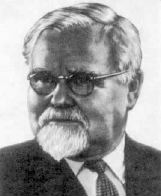

Andrei Nikolaevich Tikhonov attended secondary school as a day pupil and entered the Moscow University in 1922. His studied in the mathematics department and made remarkable
progress, having his first paper published in 1925, while he was still in the middle of his undergraduate courses.
His first work was related to conditions for a topological space to be metrisable. However he did not stop there and continued his investigations in topology. By 1926, he had discovered the topological construction which is today named after him, the Tikhonov topology
defined on the product of topological spaces. Tikhonov also proved such important topological results as the product of any set of compact topological spaces is compact.
Few mathematicians have gained a worldwide reputation before they even start their research careers but this was essentially how it was for Tikhonov. With this impressive record he became a research student at Moscow University in 1927. He defended his habilitation thesis in 1936 on functional equations of Volterra type, and their applications to mathematical physics. After successfully defending his thesis, Tikhonov was appointed as a professor at Moscow University in 1936 and then, three years later, he was elected as a Corresponding Member of the Academy of Sciences of the Soviet Union.
Tikhonov's work led from topology to functional analysis with his famous fixed point theorem for continuous maps from convex compact subsets of locally convex topological spaces in 1935. These results are of importance in both topology and functional analysis and were applied by Tikhonov to solve problems in mathematical physics.
Tikhonov's work on mathematical physics continued throughout the 1940's and he was awarded the State Prize for this work in 1953. However, in 1948 he
began to study a new type of problem when he considered the behaviour of the solutions of systems of equations with a small parameter in the term with the
highest derivative. After a series of fundamental papers introducing the topic, the work was carried on by his students.
Another area in which Tikhonov made fundamental contributions was that of computational mathematics. Under his guidance many algorithms for the solution of various problems of electrodynamics, geophysics, plasma physics, gas dynamics, and other branches of the natural sciences were evolved and put into practice. One of the most outstanding achievements in
computational mathematics is the theory of homogeneous difference schemes, which Tikhonov developed in collaboration with Samarskii.
In the 1960's Tikhonov produced an important series of papers on ill-posed problems. Tikhonov was awarded the Lenin Prize for his work on ill-posed problems in 1966. In the same year he was elected to full membership of the Academy of Sciences of the Soviet Union.
Tikhonov's wide interests throughout mathematics led him to hold a number of different chairs at Moscow University, in particular a chair in the Mathematical Physics Faculty and a chair of Computational Mathematics in the Engineering Mathematics Faculty. He also became dean of the Faculty of Computing and Cybernetics at Moscow University. Tikhonov was appointed as Deputy Director of the Institute of Applied Mathematics of the Academy of Sciences, a position he held for many years.